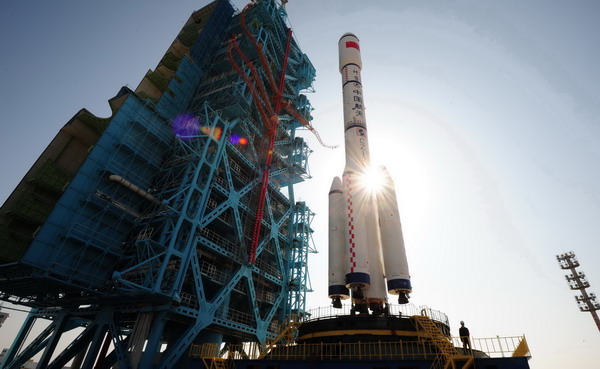Society
Forecasts signal late-week launch
Updated: 2011-09-26 07:53
By Xin Dingding (China Daily)
|
 The 8.5-ton Tiangong-1 spacecraft and the Long March II-F rocket stand at the Jiuquan Satellite Launch Center on Sept 20. The spacecraft is set to blast off at an appropriate time between Tuesday and Friday. [Shu Dong/for China Daily]
|
JIUQUAN, Gansu - Weather forecasts showed that Thursday or Friday might be suitable for launching the Tiangong-1 spacecraft, experts said.
The unmanned spacecraft, part of China's first spacecraft rendezvous and docking mission, was set to blast off from the Jiuquan Satellite Launch Center in Northwest China at an appropriate time between Tuesday and Friday.
But the latest weather forecast showed that Tuesday and Wednesday would not be suitable for a launch, Cui Jijun, chief commander of the mission's launch site system, was quoted by China National Radio as saying on Sunday.
A precondition for launching is that the average wind speed at the launch site should not be faster than 10 meters a second. The upper-level wind, at 300 meters to 25,000 meters above the Earth, should be no faster than 70 meters a second.
If the wind is too strong, the rising rocket carrier could wiggle and pose a danger, experts said.
"Everything is ready now except for the right weather," Cui said.
On Sunday afternoon, all systems of the Tiangong-1 project went through a joint maneuver, he said. Before that, the 8.5-ton spacecraft, and the Long March II-F rocket that will carry it skyward, were positioned onto the launch pad last Tuesday.
Engineers carried out checkups on the conditions of the rocket and the spacecraft, among many other tests in the past few days. All preparation work is done except for fuel loading, he said.
Wang Xiaoqing, a publicity official at the launch site, said that the fuel loading usually begins one day before the launch. Once the fuel is loaded into the carrier vehicle, the launch becomes "irreversible".
Tiangong-1, or Heavenly Palace 1, will serve as "a target spacecraft" for three rendezvous and docking experiments.
The spacecraft rendezvous and docking missions are expected to pave the way for the building of a planned space station scheduled for 2020, previous reports said.
Following Tiangong-1, an unmanned Shenzhou VIII spaceship will blast off from the Jiuquan Satellite Launch Center later this year.
Lu Jinrong, chief engineer of the mission's launch site system, said that it is rare that two launches of China's manned space program are scheduled in half a year.
"In the past, the launch site carried out one launch a year, or even one every two to three years," he said.
"We are already in a high-frequency launch period."
E-paper

Pearl paradise
Dreams of a 'crazy' man turned out to be a real pearler for city
Literary beacon
Venice of china
Up to the mark
Specials

Power of profit
Western companies can learn from management practices of firms in emerging economies

Test of character
Keyboard-dependent Chinese are returning to school because they have forgotten how to write

Foreign-friendly skies
About a year ago, 48-year-old Roy Weinberg gave up his job with US Airways, moved to Shanghai and became a captain for China's Spring Airlines.
